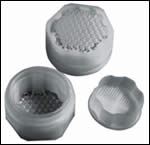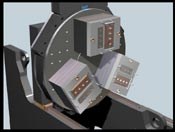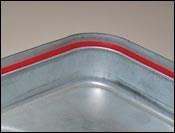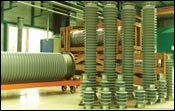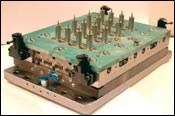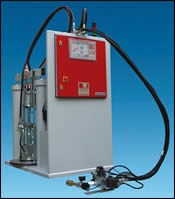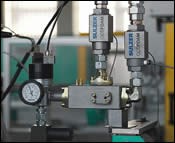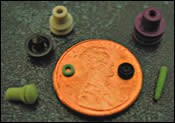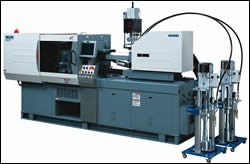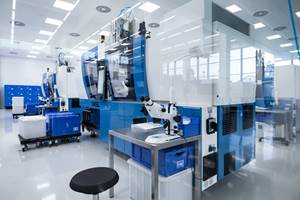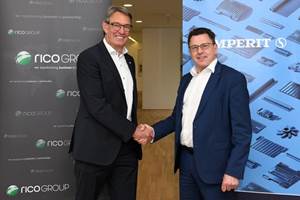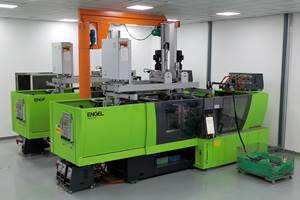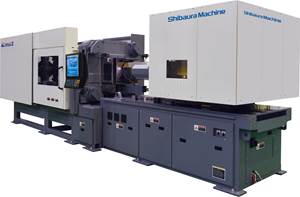Injection Molding LSR: Three 'M's of Innovation: Mega, Micro, and Multi
Liquid silicone rubber is breaking out of its niche into a broader array of applications, helped by new developments in materials, machinery, and processing. Larger parts, micro-parts, foams, and multi-color or multi-material combinations are key areas of innovation.
Opportunities for injection molders of liquid silicone rubber (LSR) are broader than ever, thanks to newer processes for foaming, multiple colors or durometers in the same part, or thermoplastic/thermoset overmolding. Improvements in the materials, machinery, and tooling are adding versatility, improving quality, and helping to lower the barriers to entry.
Today’s LSR molders have more material choices, a greater selection of tooling sources, and technology to mold micro-parts down to a ten-thousandth of a gram, as well as huge parts weighing up to 70 lb or more.
Suppliers of materials, molds, and equipment say interest in LSR has spiked in the last few years. “It is coming from plastic companies wanting to get involved and brand-new companies looking to try their entrepreneurship. Certainly medical molders are more involved too,” says Greg Roembke, executive v.p. of toolmaker Roembke Mfg. & Design. “We are finding also that the automotive marketplace is leaning toward LSR. Perhaps they have achieved as much as they can with traditional silicone gum stock and understand that if they want to go further it will be with LSR,” he adds.
LSR molders say the material has gained a beachhead in several markets as an alternative to high-consistency silicone rubber (HCR) as well as EPDM, latex, natural rubber, TPEs, PVC, and even porcelain ceramic. Because of its inertness and chemical and heat stability, LSR is commonly used in baby bottle nipples and pacifiers, valves and seals for medical devices, medical implants, medical gloves, and automotive seals. LSR is gaining a bigger share in electronic connectors, o-rings, gaskets, membranes, under-hood parts and fuel systems, says Bill French, general manager for elastomers and RTV at Momentive Performance Materials. LSR is also replacing TPEs in some soft-touch applications with high-heat requirements, such as cooking utensils.
In North America about to 10% 15% of the market in silicones is held by LSR (vs. 25% globally), the rest being gum silicone, says John Timmerman, v.p. of marketing and sales at Starlim North America, a major Austrian-based LSR molder that recently established U.S. operations. Industry sources agree that LSR is experiencing demand growth of about 15% year in North America.
One source cited a study that estimates the U.S. market for LSR to be 18 to 20 million lb/year, valued at about $85 million. The study says automotive has the largest share at 35%, with medical/health care at 25% and electronics at 20%.
Promise in ‘2K’ processes
Several process technologies, some brand-new and others attracting fresh attention, are opening new doors for LSR. The most prominent is multi-component or “2K” molding, which includes multi-material, multi-color, and multi-durometer processing. Multi-material molding is typically a two-shot process whereby a thermoplastic substrate is over-molded with LSR. Two-shot molding is most commonly executed in a molding cell with two separate presses for thermoplastic and thermoset molding. The thermoplastic substrate is molded first and is then transferred manually or robotically to the LSR machine where it is overmolded. In some cases, residual heat in the thermoplastic (such as nylon) helps cure the silicone.
Interest is growing in a different approach to thermoplastic/LSR molding, which combines both molding steps within a single machine. It was demonstrated by Nissei as long ago as 1988 at a plastics fair in Osaka, Japan. This approach requires more sophisticated tooling with a cold side for the thermoplastic and a hot side to cure the thermoset, the two zones being thermally isolated from each other. The thermoplastic substrate can be transferred to the LSR molding station in several ways, such as by a transfer plate, rotating mold, or a robot to move the part from one core or cavity to other.
Although such an approach uses only one machine and much less floorspace, it requires more investment in tooling, so it will likely have to be a high-volume application, says George Kipe, president of Kipe Molds. With more than 35 years’ experience, he is widely considered the “grandfather” of LSR molding in the U.S. Using separate presses also allows a molder to use the thermoplastic machine for other jobs as well, notes Starlim’s Timmerman.
A “two-zone” mold with a rotating core designed to mold LSR over PBT was shown at Arburg’s technology open house in Germany last year. The tool produced a six-pin electronic connector of 30% glass-filled PBT with an LSR insert in the connector face at one end and an LSR ribbed seal around the middle of the part. Both shots were produced with a “live” sprue for waste-free production. The LSR requires a cold runner around 77 F and a hot mold at 392 F, while the PBT uses a hot runner at 572 F and a mold cooled to 212 F.
The part was molded in a cycle of about 30 sec on an Arburg Allrounder 470 U hydraulic press with a vertical injection unit for the PBT and a horizontal injector for the LSR. The 4+4 cavity mold with an indexing core-insert plate was built by Rico Elastomere GmbH in Austria, an LSR tooling specialist. The drive for the insert plate was integrated into the mold so that the tool could be used on other machines.
A key issue in LSR/thermoplastic molding is ensuring adhesion between the materials. The first approach was to lock in the silicone mechanically by means of an undercut channel in the thermoplastic substrate. Subsequent approaches have used ultrasonic vibrations, plasma surface treatment, or chemical primers to bond the two materials. A currently popular solution is to use a specially modified silicone (and sometimes thermoplastic) formulation to achieve a chemical bond (see below).
Overmolding LSR on metal is also in development. Kipe says LSR can be overmolded on aluminum that is anodized for good adhesion. “There is some talk about overmolding on powdered metal too,” Kipe adds. Powdered-metal parts would have a more porous surface that could mechanically bond the LSR.
Multi-color molding with LSR has a new twist in a mold and machine concept that allows production of LSR with up to three colors using a single barrel and injection unit. Introduced this year by toolmaker M.R. Mold & Engineering and Toshiba Machine Co., this approach eliminates the need for multiple injection systems, keeps the LSR dosing equipment and molding press free of color, and shortens changeovers and setup times. The system is offered exclusively on Toshiba’s EC-NII all-electric molding presses, says technical sales manager Michael Werner.
The key to the process is the use of valve-gate runner nozzles installed in the tool, which deliver color to each individual cavity when required, says Jim Albert, general manager at M.R. Mold. Each mold cavity has a nozzle for each color and a separate nozzle for the LSR. The color is premixed at the back end of the tool before it enters the cavity. Toshiba’s V-30 controller monitors each step of the process. The tooling ensures that the colors are applied accurately, without gaps or bleed-through. The concept was demonstrated in the production of a white LSR plaque with separate red and blue stripes.
Another multi-material approach that uses two LSR materials of different durometers was demonstrated as long as eight years ago by Engel, says Mark Hammond, technology group manager. Engel developed a coinjection system that combines the two LSR streams inside a cold-runner tool. This technique was aimed at automotive fuel lines, where a lower cost LSR serves as the part’s core while a premium high-performance grade can be used sparingly as the skin. Engel and other sources say dual-durometer LSR parts are quite rare.
Physical foaming arrives
A brand-new process that allows for physical foaming of the LSR during injection molding is said to be an industry first. The Optifoam process was developed by the Swiss parent of Sulzer Chemtech USA. Physical foaming of LSR with CO2 reportedly can be more repeatable and controllable than chemical foaming, though LSR foaming of any type is still a small segment of the market.
Sulzer’s new Optifoam process, commercialized this past summer, reportedly can provide 30% to 60% weight reduction, saving expensive material, and lowers Shore hardness by up to 50% for a softer feel, says Lukas Stirnemann, product manager for plastic processing mixing and reaction technology. Unfoamed LSR has a density of 1.1 g/cc, which can be reduced to 0.45 g/cc.
The Optifoam process adds nitrogen or CO2 under pressure (1450 to 2900 psi) to both the “A” and “B” LSR components through metering units connected to each material feed line. Introducing the gas in a “supercritical” state enables the gas to diffuse fully into the LSR materials. The gas-loaded LSR components come together in a special static-mixing manifold before entering the mold. Sulzer says its static mixer is three to four times more effective than mixing by the injection screw in chemical foaming, and it homogenizes with low shear forces. Uniform distribution of gas into the material reportedly results in uniform foam cells. Sulzer also developed a shutoff nozzle to prevent premature foaming in the barrel.
Mega to micro parts
High-voltage electrical insulators have been a goal for LSR molding for nearly a decade. “These parts are looking to replace EPDM, porcelain, or ceramics and can be 8 to 10 ft tall, weighing 80 to 90 lb,” says Jim Papa, Americas marketing manager for elastomers and RTV at Momentive Performance Materials (formerly GE Silicones).
“Ceramic insulators are extremely heavy compared with an LSR part. So one driver here may be a part that is easier to manufacture, transport, and install,” adds Bill French of Momentive. LSR high-voltage insulators have been molded in relatively small numbers in Europe. Now there is a commercial application in the U.S., according to one LSR moldmaker, who could not release further details.
When it comes to molding larger parts, most LSR molders are limited by small injection presses and small shot capacity. Custom molder Limtech Inc. in Sturtevant, Wis., overcomes this problem by using an old technique called intrusion molding, which is probably unfamiliar to most LSR molders. Limtech has molded 1.2-lb LSR inserts for medical sterilization trays on an 88-ton Boy Machines press with only 8-oz shot capacity. After the mold locks up, the injection shutoff nozzle opens, and the screw rotates without moving forward, acting like an extruder. After filling most of the shot under low pressure, the screw moves forward for the final filling and packing steps under high pressure. Limtech’s experience with intrusion molding allows it to fill the mold completely before the extruded material sets up and to prevent flow lines between the extruded and injected material.
LSR molders are also pushing the envelope on the other end of the size scale with micro-molded parts. “Producing miniature or micro-sized parts in high-cavitation molds is another industry development,” says Javier Cruz, product development engineer at Simtec Silicone Parts LLC, an LSR molder in Madison, Wis. Simtec has 128-cavity tools molding LSR parts weighing 0.1 to 0.2 g and it is eyeing the possibility to go to 256 cavities.
Micro-molded parts are being used in medical and healthcare applications such as implantable devices, resorbable devices or items like bio-needles or components for hearing aids. Micro-molding consultant Donna Bibber, president of Micro-Engineering Solutions, was involved with a project to mold an LSR hearing-aid component that measured 0.050 in. with features as small as 0.0007 in. The gates were 0.002 in. The lightest LSR part she knows of weighs only 0.0001 g and measures 0.060 in.
New choices in materials
Hundreds of two-component LSR formulations are available from suppliers such as BlueStar, Dow Corning, Momentive, NuSil, Shin-Etsu Silicones, and Wacker Chemical. However, Laur Silicones claims to be the first to offer a one-component LSR for injection molding. This eliminates the need for the typical two-component metering system and static mixer, unless you need to blend in a color, says Daniel Laur, president. “You get improved consistency of part properties since the material comes completely compounded and ready to use. Molders do not have to balance the ratio between the two components.” he adds. “We can even blend different durometers of LSR, which is something that cannot be done with a two-component system,” he adds Laur.
Laur offers four grades ranging in durometer from 31 to 60 Shore A. They reportedly process similar to a two-component LSR but are less sensitive to cure inhibition or air curing. When stored below 32 C (0ºF) it has a shelf life of three months. Laur says it is closer in price to an HCR silicone (typically less expensive than LSR).
As noted above, self-adhesive LSR formulations are gaining interest for overmolding on thermoplastics. BlueStar Silicones (a new company formed by the purchase of Rhodia’s silicones unit by China National BlueStar Corp. in Beijing) recently introduced Silbione LSR 60, a 60 Shore A self-adhesive grade for healthcare applications.
Dow Corning recently broadened its self-adhesive line with a Silastic LC L 50/900sa-select grade for bonding with nylon, PBT, and possibly PC/ABS. In an unusual twist, Dow Corning also came up with a self-adhesive LSR that bonds to thermoplastics in molding but also can be readily separated from the substrate to allow the thermoplastic to be recycled. The two materials can be separated during a float/sink gravity-separation operation, says Craig Gross, application engineer.
Shin-Etsu recently rolled out Select-Hesive KE2017 and KE2018 self-adhesive grades, the latter of which is also self-lubricating. New Select-Hesive KE2090 and KE2095 LSRs (30 to 70A) boast fast cure and strong bonding to various engineering thermoplastics under high heat and humidity and thermal cycling (see p. 29 for more details). “The substrate does not need to be modified to use our self-adhesive materials,” says Eric Bishop, North American marketing manager.
Wacker Silicones says U.S. molders are showing “considerable interest” in its self-adhesive LSR grades, which were developed at the parent company in Germany. This line is said to be exceptionally broad, encompassing standard, healthcare, self-lubricating, and oil-resistant grades, all with excellent adhesion to many plastics.
Other themes in LSR materials development include higher tear strengths; faster-curing grades for larger, thicker parts; self-lubricating grades to reduce the coefficient of friction where a slippery surface is needed; and liquid fluorosilicone elastomers offering enhanced resistance to automotive fuels.
BlueStar, for example, added a 40 Shore A translucent, high-strength, self-lubricating grade for healthcare uses as part of its new Silbione 4300 series. Two others in the series are the 60A self-adhesive grade noted above and a 40A grade for thick parts that’s said to cure 30% to 50% faster than standard grades (e.g., 12 to 13 sec at 347 F). The company also has a developmental supersoft 5A grade for gel-like applications in healthcare.
Earlier this year, Dow Corning introduced Silastic LC-45-2004, a high clarity grade with superior mechanical properties for consumer products and baby nipples, and Silastic LC-50-2004 for valves and seals on food containers and dispensers. New Silastic LC70-2004 is a harder material for mobile-phone keypads, bakeware, and mats.
Dow Corning is also developing self-lubricating grades for connector seals and is looking to enhance its S series of high performance materials for medical implantables, says Americas technical director Steven Waier. The company plans to introduce new fluorosilicones for automotive use.
Momentive Performance Materials debuted several new materials at last month’s K show in Germany, including a new high-clarity high-refractive-index (around 1.5) grade designed to mold complex-shaped lenses in one shot. It represents a new market for LSR, says French. “We are targeting optical clarity comparable to glass or PC.” he notes. The material is aimed at LED applications.
At K, Momentive also unveiled a new UV-curing approach that takes place in the mold and shortens cycles, according to French.
Shin-Etsu rolled out four new LSRs (5 to 20 Shore A) in the KE series, designed to impart an enhanced soft-touch feel without sacrificing strength, says Bishop. Shin-Etsu also introduced new high-temperature, low-volatile, self-lubricating grades for automotive, and high-tear-strength materials (see p. 29).
At the K Show, Wacker brought out a new tear-resistant grade with improved puncture resistance and the LR 3060 self-lubricating line, says elastomer sales manager Ed Laperriere.
Tooling developments
LSR toolmaking remains the province of a small handful of specialists, including Kipe Molds, Kingson Mold and Machine, M.R. Mold & Engineering, and Roembke Mfg. & Design. Sources at Roembke say the major demands or concerns of domestic LSR customers nowadays are higher cavitation, flash prevention—since the very low viscosity material easily shoots through gaps as tiny as 0.0002 in.—and cold-runner valve gates for tighter part tolerances.
In Europe, home to the three biggest names in LSR tooling (all Austrian), open nozzles are usually preferred to valve gating. “Open-nozzle designs have fewer moving parts and are more trouble-free—if you don’t stop production. However, the more expensive valve-gate nozzle better separates the hot tool from the cold runner, allows for sequenced or profiled filling to each cavity, and leaves little to no gate vestige or chance for a cold slug in the part,” says Kingson sales engineering manager T.K. Lee.
A valve-gate nozzle costs about 50% more than an open system, and takes up more space than an open nozzle. As Lee noted, a cold slug can form in an open-nozzle system at the boundary between the hot mold and cold nozzle, where it can be pushed into the cavity on the next shot. That may be or may not be a problem, depending on the part, and there are tricks that can be used to minimize the impact of the slug.
Kipe molds has produced 96-cavity tools with valve gates that produce 600,000 parts/day. Kipe has built LSR molds with up to 128 cavities.
Kingson produces LSR molds from 4 to 128 cavities. Demand has grown to such an extent that the firm is building a technical center to demonstrate its capabilities and conduct mold trials. It will install a 45-ton press from Sodick Plustech and a 70-tonner from another Japanese OEM.
M.R. Mold produces valve-gated tools from 8 to 32 cavities. Roembke stops at 64 cavities, which keeps a balance between mold costs and tooling complexity, says Greg Roembke.
Of the three Austrian LSR toolmakers, Elmet is the only one so far with a sales and service office in the U.S., says Susan A. Patterson, project coordinator. “Activity is increasing here. U.S. customers are now asking for packages of several LSR tools rather than one or two,” she says. Elmet offers standard and custom valve-gated tools with up to 32 cavities. Elmet displayed a 256-cavity mold at the K show on a KraussMaffei press. It was designed for a seal part weighing less than 0.1 g.
Like its Austrian competitors, Rico Elastomere and Hefner, Elmet can supply a complete turnkey system (including its own two-component dosing units) as a single-source supplier. At the NPE 2006 show in Chicago, Alba Enterprises introduced its CRS cold-runner system for up to 32 cavities. It has valve-gate nozzles that can gate up to four parts per drop and water circuits profiled to deliver uniform cooling to each nozzle, says Tony Brusca, Alba president.
A cold-runner design also comes from Seiki Corp. of Japan (known for its Spear hot-runner thermoplastic system). Its Rudiz valve-gate LSR system is offered here through Mitsui Plastics.
Fisa offers a water-cooled cold-runner version of its spring-loaded valve-gate nozzle, which is opened by injection pressure on the material. The spring forces the pin shut as soon as injection pressure ceases.
D-M-E offers its KKS standardized cold-runner line with two to 64 drops. It can handle shots from 1.1 to 132 lb, says Robert Starr, director of global marketing services.
The newest development from D-M-E is the adaptation for LSR of a thermoplastic stack-mold concept called a tandem mold. Introduced at the K Show last month, this is the result of collaboration between D-M-E and T/Mould of Germany, supplier of TandemMould, a patented, four-year-old stack-mold system that opens and closes each of two mold faces in alternating cycles. D-M-E is now the exclusive worldwide agent for LSR applications of the TandemMould.
The system can be used with a standard injection press fitted with new cold-runner and water-cooled nozzle technology developed by D-M-E for LSR and rubber. The mold has a center section with two parting lines and an electric or pneumatic locking mechanism that allows each parting line to open on alternate cycles, so the tool in one parting line is filling while the other is opening to eject parts, explains Manfred Sander, a product manager at D-M-E in Germany. This approach means a large injection unit is not needed since only one mold is filled at a time.
D-M-E designed a central sprue bushing with a shutoff nozzle where the elastomer enters the middle platen for distribution to the cavities. Standard molds can be used in each parting line, yielding twice the production at a 40% cost reduction compared with using two presses.
Injection/dosing systems
Outfitting an injection machine for LSR generally requires a two-component metering/mixing (or dosing) system to feed the silicone to the injection barrel. In the U.S., most injection machine suppliers use LSR dosing equipment built by third-party companies such as 2KM, Fluid Automation, and Graco/Liquid Control.
Among recent developments, 2KM unveiled three new systems at last month’s K Show. Its Silcostar 950H model allows for a higher range (6% to 7%) of variance from the typical 1:1 ratio between A and B components in order to customize material properties. 2KM also showed its new ProcessFlowMix mix-ratio control for molding large LSR parts. The unit is now driven by all-electric servomotor instead of hydraulics or pneumatics for more precise control.
Fluid Automation recently developed a new valve-gate nozzle that attaches to the front of the injection unit. It comes in four versions for low- to high-volume molding. V.P. of sales and marketing Bob Pelletier adds that the company offers several variable-ratio systems allowing adjustment of 2:1 or 5:1.
Most injection machine suppliers offer an LSR package to convert their presses for molding silicone. The package commonly includes a special low-compression screw, water-cooled barrel, shutoff nozzle, and check ring. Molders have a choice of plunger or two-stage screw/plunger designs from firms like Sodick Plustech, Gluco, or Engel; or reciprocating-screw units from Arburg, Battenfeld, Billion, Boy, Engel, Milacron, Nissei, Toshiba, and Sumitomo, and others. They are available in hydraulic and newer all-electric versions.
“We have seen demand for all-electric presses from molders of LSR automotive and medical parts for at least 10 years,” says Kent Royer, Roboshot product sales manager at Milacron. “The precision positioning and velocity control is a high requirement. Electric machines can control injection velocities down to 0.01 in./sec.,” he adds.
Toshiba sources agree on this trend. “We have highly accurate servomotors that have a resolution greater than 0.00002 in. and response time of 0.1 millisec,” says Toshiba’s Werner.
Related Content
LSR Molder Invests in Canadian Operation
Starlim is investing $10.4 million in its London, Ontario, LSR injection molding site, with plans to add 26 jobs.
Read MoreSemperit Acquires Rico Group
The global maker of specialized polymer products for industrial applications, including hoses and belts, has purchased the Austrian headquartered liquid silicone rubber molder and moldmaker.
Read MoreDatwyler Expands O-Ring Production
The company has added injection molding machines to production sites in Mexico and China to boost production.
Read MoreCompletely Connected Molding
NPE2024: Medical, inmold labeling, core-back molding and Industry 4.0 technologies on display at Shibaura’s booth.
Read MoreRead Next
Lead the Conversation, Change the Conversation
Coverage of single-use plastics can be both misleading and demoralizing. Here are 10 tips for changing the perception of the plastics industry at your company and in your community.
Read MoreMaking the Circular Economy a Reality
Driven by brand owner demands and new worldwide legislation, the entire supply chain is working toward the shift to circularity, with some evidence the circular economy has already begun.
Read MorePeople 4.0 – How to Get Buy-In from Your Staff for Industry 4.0 Systems
Implementing a production monitoring system as the foundation of a ‘smart factory’ is about integrating people with new technology as much as it is about integrating machines and computers. Here are tips from a company that has gone through the process.
Read More



